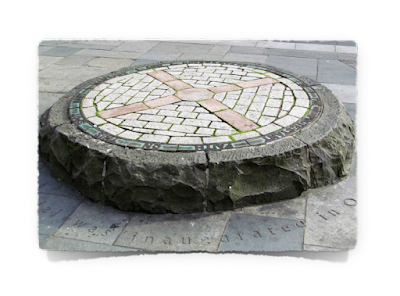John Nisbet and Scotland's Covenanted God
In September 2016, I took a tour of Scotland with my family; among other things, it was a belated graduation present for completing my bachelor’s degree. Knowing only vaguely that the name “Nesbit” was Scottish and that a Scottish clan of the same name existed, my father and I assumed that we had some vague connection. While touring the beautiful city of Edinburgh, we came to a place called the Grassmarket and were first introduced to a group that would forever alter my research as a historian: the Covenanters. We were told about the Killing Time, in which many of these Covenanters were killed – martyred, even – for their faith. While standing at the Grassmarket memorial in the middle of Edinburgh, my father and I couldn’t help but notice the name of a man who we assumed must have been a distant cousin – John Nisbet of Hardhill, executed at the Grassmarket on December 4, 1685.
A few months after the trip (January 2017), I was doing some research on ancestry.com and finally managed to overcome a brick wall caused by an alternate spelling of my last name. By so doing, this took my understanding of my family history from simply my great-grandfather, James Fred Nesbit (1888-1960), all the way back for generations across the United States, across the Atlantic Ocean, and back to the Nesbit/Nisbet family’s origins in Scotland. Far from a “distant cousin,” that same John Nisbet executed in 1685 was almost certainly a direct ancestor.
Most importantly, John Nisbet’s life account was related in the anonymously-published hagiography concerning Covenanter martyrs, A Cloud of Witnesses for the Royal Prerogatives of Jesus Christ, first published in 1714. His life was also included in the closely related work by John Howie, Biographia Scoticana: or, a Brief Historical Account of the Most Eminent Scots Worthies, first published in 1775. According to these works, John Nisbet, was “one of the most eminent among the covenanters of his day,” [1] the descendant of Murdoch Nisbet (famed for his translation of the New Testament into Scots), [2] and an outspoken follower of Richard Cameron. [3] These "Cameronians" comprised the main body of Covenanter military resistance to the Stuart Restoration in Scotland.
John Nisbet fought in virtually all major Restoration battles between Covenanters and the crown – Rullion Green (1666), Drumclog (1679), Bothwell Bridge (1679), [4] and Airds Moss (1680). [5] At Rullion Green, it was said that “He fought till he was so wounded, that he was stripped for dead among the slain; and yet such was the providence of God, that, having more work for him to accomplish, he was preserved.” [6]
These two works are extremely valuable in the broader Covenanter historiography, as they include many execution speeches and testimonies given by the executed. John Nisbet is such an example. While his final speech is far too lengthy to be published in its entirety here, this interesting statement was included: “But I am persuaded, Scotland’s covenanted God will cut off the name of the Stuarts…And although men idolize them much now, yet ere long there shall none of them be to tyrannize in covenanted Britain any more.” [7] While the Glorious Revolution of 1688 was a major shift away from Stuart power, the death of Queen Anne in 1714 saw this dying utterance fulfilled.
At the close of this speech, John also stated “My soul doth magnify the Lord, my soul doth magnify the Lord. I have longed these sixteen years to seal the precious cause and interest of precious Christ with my blood, who hath answered and granted my request.” [8]
A brief chapbook concerning Nisbet’s life and death was published in 1718, containing largely the same account as found in A Cloud of Witnesses and Scots Worthies – almost certainly compiled from the two sources. However, an intriguing postscript states that John died “with the full Assurance of his Interest in the ever Blessed LORD JESUS CHRIST; as also of the LORD’s returning to this poor Land, to raise up the fallen Tabernacle of David therein in a more remarkable Way and Manner, than ever; which Sight he saw a far off by Faith, and rejoiced thereat.” [9]
These passages are but one of many given in these two works; while some modern histories portray these groups as rebels, it is clear through even a cursory reading of the sources that the executed were deeply committed to their religious beliefs.
In 2019, I returned to Scotland along with my father. We paid proper respect to the Grassmarket Memorial, quietly praying and thanking God for His mercy in bringing us back to the site, this time with the full knowledge of our ancestor’s sacrifice. I also stopped in a nearby bookshop and purchased a copy of Scots Worthies to sit on my bookshelf as a prized reminder of the goodness of God.
In 2020, I began a graduate program in history, and my master's thesis, entitled "Scotland's Covenanted God: The Divine Right of Kings and the Scottish Kirk" focused directly on the political and religious motivations of the Covenanter movement.
––––––––––––
[1] John Howie, Biographia Scoticana: or, a Brief Historical Account of the Most Eminent Scots Worthies, ed. William McGavin, 2 vols., 4th ed. (1775; repr., Glasgow, 1828), 2:429.
[2] Ibid., 1:475.
[3] Ibid., 2:530.
[4] Ibid., 1:476. See also A Cloud of Witnesses for the Royal Prerogatives of Jesus Christ (n.p., 1714), 250-252.
[5] Howie, 1:484. This final inclusion was the battle in which Richard Cameron was killed.
[6] Ibid., 1:476.
[7] Ibid., 2:530.
[8] Ibid., 1:485.
[9] A True Relation of the Life and Sufferings of John Nisbet in Hardhill, His Last Testimony to the Truth (Edinburgh, 1718), 24.


%20copy.jpg)


Comments
Post a Comment